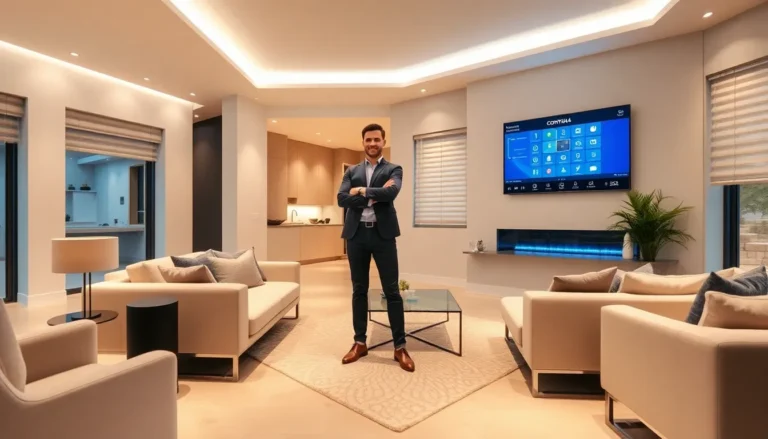Table of Contents
ToggleAs summer sizzles and temperatures soar, the quest for a cool oasis at home becomes a top priority. Enter smart home cooling solutions—your new best friends in the battle against heat. Gone are the days of sweating it out with clunky fans and high energy bills. With a sprinkle of technology and a dash of innovation, keeping cool has never been easier or more fun.
Overview of Smart Home Cooling Solutions
Smart home cooling solutions encompass a variety of technologies designed to enhance comfort and reduce energy consumption. These systems include smart thermostats, which automatically adjust temperatures based on user preferences and occupancy. Additionally, smart air conditioners provide remote access, allowing users to control settings from their smartphones or tablets.
Sensors play a crucial role in these systems by detecting humidity levels and adjusting cooling accordingly. Many smart cooling devices integrate with home automation systems, enabling smooth coordination with other smart appliances, such as fans and dehumidifiers. These integrations contribute to a seamless, energy-efficient cooling strategy that adapts to seasonal temperature fluctuations.
Investing in smart cooling solutions offers significant cost savings. Energy-efficient models can lower utility bills by using advanced algorithms to optimize cooling cycles. For instance, utilizing peak and off-peak hours helps maximize energy savings while maintaining a comfortable environment.
Another advantage of smart cooling systems is their ability to collect data. Continuous monitoring reveals usage patterns, empowering users to make informed decisions about their cooling habits. Accumulating this information helps homeowners identify opportunities for further energy savings.
Popular brands in the smart cooling market include Nest, Ecobee, and Honeywell, each providing unique features that cater to diverse needs. Select devices allow integration with voice-controlled assistants, enabling hands-free temperature adjustments. Moreover, many models offer features such as geofencing, where the system automatically adjusts when homeowners leave or return.
Smart home cooling solutions redefine comfort in residential spaces. Their advanced technology not only enhances individual well-being but also promotes sustainable energy usage. Adopting these innovations prepares homes for increasingly warmer summers.
Benefits of Smart Home Cooling Solutions
Smart home cooling solutions offer significant advantages in energy savings and comfort during hot months. These systems employ innovative technology to enhance residential environments.
Energy Efficiency
Smart cooling solutions drastically reduce energy consumption. They utilize advanced algorithms to optimize cooling cycles based on user preferences and real-time conditions. Smart thermostats adjust automatically, minimizing energy waste when homes are unoccupied. In fact, studies show energy-efficient models can lower utility bills by up to 30%. Moreover, systems integrate with home automation, allowing for coordinated operation with other energy-efficient appliances. Users gain insights through collected data on usage patterns, enabling informed decisions to further save energy.
Improved Comfort
Enhanced comfort defines the experience of smart cooling systems. These technologies adjust not only to temperature preferences but also to humidity levels, ensuring a pleasant indoor climate. Sensors actively detect fluctuations in air quality and humidity, automatically making necessary adjustments. Voice-controlled features further simplify user interaction, allowing easy temperature adjustments from anywhere in the home. Geofencing capabilities enable cooling systems to activate or deactivate based on a user’s location, providing convenience without sacrificing comfort.
Types of Smart Home Cooling Solutions
Smart home cooling solutions include various technologies that enhance comfort and save energy. These innovations cater to diverse cooling needs and preferences.
Smart Thermostats
Smart thermostats offer precise temperature control and adaptability. They learn user behavior, adjusting settings automatically to optimize energy use. Integration with smartphone apps allows for remote adjustments, promoting convenience. Many models feature geofencing, which adjusts temperatures based on occupants’ locations. Brands like Nest and Ecobee provide detailed energy reports, enabling homeowners to track usage patterns and make informed decisions. Significant cost savings occur, as users can lower energy bills by up to 30%.
Smart Air Conditioners
Smart air conditioners deliver cooling with advanced technology. These units connect to Wi-Fi, enabling remote operation via mobile devices. Customizable settings enhance user experience, allowing adjustments based on preferences. Some models even respond to environmental factors like humidity, providing more effective cooling. Integration with home automation systems enables coordination with other smart devices. Energy-efficient designs not only ensure comfort but also contribute to reduced utility costs. Popular brands include LG and Frigidaire, known for their reliability and user-friendly features.
Smart Fans
Smart fans combine technology with traditional airflow methods. These devices allow users to control settings through smartphone apps or voice commands. Some fans adjust speed and direction automatically based on room conditions. Many models integrate with smart thermostats, helping to distribute cool air efficiently. Energy-efficient designs promote reduced electricity usage while maintaining comfort. Brands like Dyson and Honeywell offer innovative features, including oscillation and timer functions, enhancing flexibility in cooling solutions. Homes benefit from consistent airflow, creating a more comfortable indoor environment.
Features to Look for in Smart Cooling Solutions
Smart cooling solutions offer various features that enhance user experience and efficiency. Key functionalities include remote control and automation, along with integration with existing smart home systems.
Remote Control and Automation
Remote control capabilities provide users with immediate access to their cooling systems via smartphones or tablets. Automation features enable smart thermostats and air conditioners to learn individual habits, adjusting temperatures accordingly. Users can set schedules, ensuring optimal comfort when they are home. Some systems even support geofencing, which adjusts the temperature based on the homeowner’s location. Such efficiency contributes to energy savings by reducing waste when no one is present.
Integration with Smart Home Systems
Compatibility with smart home ecosystems is essential for maximizing the benefits of cooling solutions. Smart cooling devices allow seamless communication with other appliances, including smart lighting and security systems. Integration enhances convenience, enabling users to manage their home’s environment through a single interface. Voice-controlled features often enhance usability, allowing for hands-free operation. Furthermore, cohesive systems enable coordinated climate adjustments based on real-time data from environmental sensors, creating a harmonious home atmosphere.
Smart home cooling solutions are revolutionizing how homeowners manage indoor comfort during the sweltering summer months. By leveraging advanced technology these systems not only enhance comfort but also promote energy efficiency. The integration of smart thermostats and air conditioners allows for personalized climate control that adapts to individual preferences and occupancy patterns.
As energy costs continue to rise investing in these innovative cooling solutions can lead to substantial savings. With features like remote access and automation users can enjoy effortless control over their home environment. Embracing smart cooling technology is a step toward a more comfortable and sustainable living space ensuring that homes remain cool and inviting even during the hottest days.







